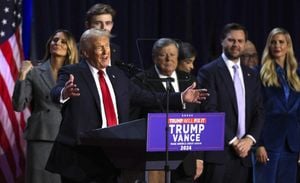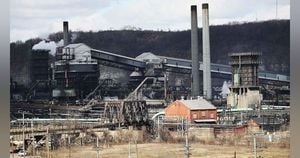With the rapid shifts seen from the White House over the past few years, the economy has been at the heart of political contention. Since Donald Trump’s return to the presidency as the 47th President of the United States, speculation has raged over how his policies will impact everything from local job growth to the international market. On the campaign trail, Trump zeroed in on economic themes, vowing to rejuvenate the economy through fiscal reforms, tax cuts, and deregulation, pledging to "Make America Great Again." His promise was aimed at boosting both the American workforce and industries he argued were beleaguered by international competition.
After his recent election, financial markets took a bullish turn, igniting investor enthusiasm about the economic possibilities under Trump's leadership. The U.S. stock exchanges reacted by climbing almost immediately. But what exactly spurred this wave of optimism?
Trump's economic approach is underscored by several hallmark policies enacted during his first term, the most significant being the Tax Cuts and Jobs Act of 2017. The Act slashed the federal corporate tax rate from 35% to 21%, with promises of future reductions. This restructuring enabled companies to retain more of their earnings, theoretically leading to increased investment and growth. By the day after his recent victory, this policy was already provoking echoes of the economic boom witnessed post-2017. The memories of rising investments not only energized the stock markets but also allowed bitcoin to surge 6% during trading hours.
Alongside tax cuts, Trump's administration also focused on regulatory reforms—significantly loosening constraints on businesses, especially those within the energy and finance sectors. This rollback facilitated easier paths for companies to grow, take risks, and increase profits. Investor sentiment surged as they anticipated continuing favorable conditions for business under Trump’s second administration.
The environment of low interest rates during Trump's first term reinforced these gains. Although the Federal Reserve operates independently from the presidency, it maintained low borrowing rates—an arrangement conducive to economic stimulation. Interest rates were adjusted downwards shortly after Trump's electoral success, showcasing flexibility to keep the economy warm and vibrant.
Trump's economic strategy is also rooted deeply within the framework of American industry. Pushing for enhanced infrastructure investment and American manufacturing, Trump's policy pushed tariffs on imports, especially from China, as part of his broader initiative to protect U.S. industries. The rationale here was simple: squeezing out international competitors would encourage domestic producers to bloom, which he argued would trickle down to job creation and rising wages for American workers.
Interestingly, Trump has characterized prior U.S. military engagements, particularly those involving Middle Eastern nations, as stifling to economic progress back home. According to Trump, international conflicts induce volatility—a theme he reiterated following his election, noting how geopolitical tensions often lead investors toward safer decisions, such as investing in gold and U.S. Treasury bonds. His comments suggested prioritizing strategies aimed at quelling instability overseas could create favorable conditions for both global and domestic markets.
The ramifications of Trump's policies aren't exclusive to the American economy. His trade approach has significant ramifications for Europe. Trump previously clashed with European allies over defense spending, insisting NATO member nations increase their contributions. Analysts warn this could divert economic resources from other developmental initiatives across Europe, posing challenges for inflationary pressures—especially concerning global defense budgets.
During his initial term, the imposition of tariffs on European goods had ripple effects, leading to increased costs for consumers on both sides of the Atlantic. Trump's commitment to potentially extend tariffs to sectors such as food, automotive, and fashion brings uncertainty, particularly as key European economies navigate the dual pressures of inflation and trade relations. Observers predict these moves could strain economic collaborations and lead to retaliatory actions undermining transatlantic ties.
The unpredictable essence of Trump’s policies extends to Sino-American relations as well. Reinforcing the trade war narrative, Trump has indicated plans for substantial tariffs against Chinese consumer products—aiming for as much as 60%. Given the current vulnerabilities within China's economy—where debt and dependence on exports have made the country susceptible to external shocks—such tariffs could cultivate economic strain.
Chinese reliance on exports constitutes around 15% of its GDP, and adjustments to tariffs carry significant repercussions with each potential move. Industry experts indicated China's limited household consumption is another area of vulnerability, potentially exacerbated by any shifts tied to increased tariffs. Trade experts like Alicia Garcia Herrero have voiced skepticism about China's maneuvering capabilities, arguing the government must stabilize internal markets rather than escalate tensions.
While the future course of Trump’s economic vision remains to be seen, its impacts will surely be watched closely by global financial markets. Economists are split on the potential effectiveness and ramifications of Trump’s policies. Supporters tout tax cuts as facilitating corporate growth and resulting job creation. Conversely, critics highlight risk factors tied to wealth inequality and increasing federal debt, which could stymie fiscal flexibility down the road.
Critics raise alarm on broad trade policies, underscoring their potential to disrupt global supply chains, inflate consumer prices, and create uncertainty in the international marketplace. The short-term benefits touted by supporters hint at fundamental challenges lurking around the corner, not to mention the ever-present looming specter of increased financial inequity between the wealthy and the working class.
The effects of Trump's uncompromising trade approach aren’t limited to the U.S. markets. Economic observers across South Asia may discover the potential for renewed relations should Trump reinvigorate ties with India, positioning it as a counterweight to Chinese influence. With Trump’s strong ties to Prime Minister Modi, U.S.-India relations could catapult as they collaborate against economic and strategic risks stemming from Beijing.
Analysts are carefully dissecting the future impact of Trump’s policies on the broader economy, drawing connections between the fiscal strategies and their effects on various sectors. Negativity lingers around predictions of inflation, as some strategies could inflate costs without yielding sustainable benefits for consumers. The complexity of Trump’s economic policies, rooted deeply within issues of inequality, trade, and international engagements, adds layers to discussions on how best to prepare for the potentially turbulent waters of the future.
With the dust settling from the recent election, all eyes will undoubtedly remain fixated on how Trump’s economic targets will materialize, and whether the projected inflationary pressures will actualize or fade away. The reactions from both Wall Street and Main Street will be closely observed as policies shift from rhetoric to action, potentially reshaping the nation’s economic fabric once more.



